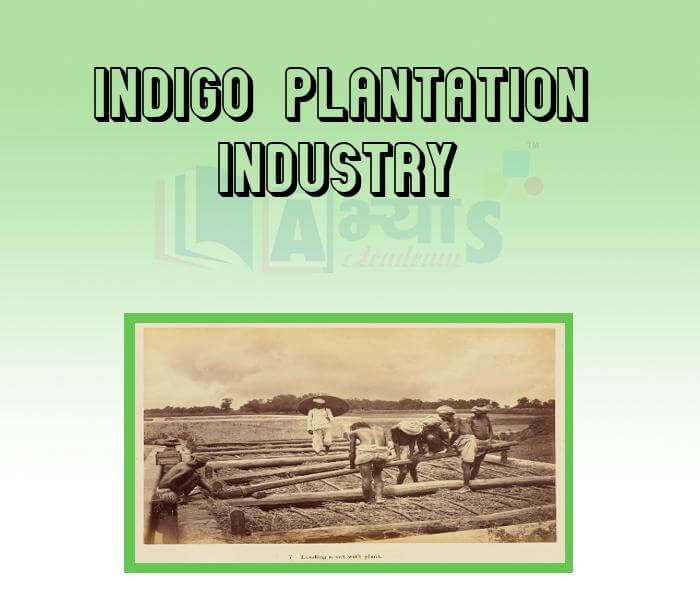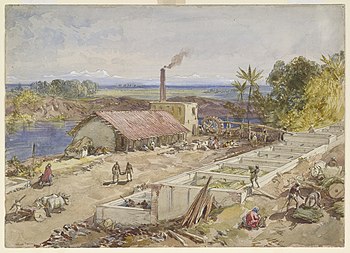Indigo Plantation Industry












Indigo Plantation Industry
Indigo: Indigo, a plant that produces a blue dye, was an important part of South Carolina's eighteenth-century economy. It was grown commercially from 1747 to 1800 and was second only to rice in export value. An important dye for the textile industry, indigo was cultivated on a large scale by the British colonists. Indian peasants were forced to work in indigo plantations under inhuman conditions.
Before the Portuguese, who were the first Europeans in India, traded with India there was extensive trading for centuries by the Arabs between the west coast of India and southern Europe. The Indigo plant or dye was one of the items of trade.
These dyes - brilliant purple and reds - were very expensive and only the Roman Emperors and the very wealthy could afford them hence the term "the royal purple". The range from deep red to purple to deep blue can be obtained by adjusting the pH (acidity - alkanility) of the solution. It was the Portuguese who gave the dye or plant the name "Indigo" meaning "from the indies". The Arabs called the dye "a-nil" meaning "the blue" - they just used the adjective and left out the noun. "Nil" is blue in Sanskrit as in the Nilgiri Hills in Southern India which translated means the "Blue Hills" as they look blue from the plains due to the combination of mist and heavy rain forest.
In the late 1800's the Germans - and later the British - synthesized these indigo dyes chemically and used the original arab or Sanskrit name in calling them "anilin dyes" which is the term used in chemistry books. Unfortunately the chemical synthesis of these dyes by the Europeans effectively destroyed the indigo industry in India. During World War II in India we couldn't get the synthetic dyes or fabric from England; instead we used Indian fabrics dyed with the Indian indigo dyes.
The Plantation Industry: A plantation is a place where cash crops are grown on a large scale. You have already seen how Indian farmers were forced to cultivate cash crops in the place of food grains. Indigo, tea, jute, rubber and cotton, were some of the cash crops grown.

workers harvesting indigo in early 19th century Bengal.
How was Indigo cultivated? There were two main system of indigo cultivation – nij and Ryoti. Within the system of nij cultivation, the planter produced indigo in lands that he directly controlled. he either bought the land or rented it from other zamindars and produced indigo by directly employing hired laborers.
How was indigo produced? The indigo villages were usually around indigo factories owned by planters.after the harvest , the indigo was taken to the vats in the Indigo factory . three or four vats were needed to manufacture the dye .

Indigo factory located near indigo fields in 1863.
Each vat had a separate function . the leaves stripped off the Indigo plant were the first soaked in the warm water in the vat for several hours.when the plants fermented , the liquid began to boil and and bubble . now the rotten leaves were taken out and the liquid drained into another vat that was placed just below the first vat.
In the second vat the solution was continuously stirred and bitten with paddles. when the liquid turned green and then blue , lime water was added to the vat.the indigo separated out in flakes , a muddy sediment settle at the bottom of the vat and a clear liquid rose to the surface . The liquid was drained off and the sediment the indigo pulp transferred to another vat and then pressed and dried for sale.
The problem with nij cultivation: In the Nij cultivation , the planter produced produced indigo on land that he directly controlled . he either bought the land or rented it from other zamindars and produced Indigo by directly employing hired labourers.
The planters found it difficult to expand the area under nij cultivation. Indigo could be cultivated only on fertile lands, and these were all already densely populated. Only small plots scattered over the landscape could blocks to cultivate indigo in plantation. They attempted to lease in the land around the indigo factory, and evict the peasants from the area. But this always led to conflicts and tension. Nor was labour easy to mobilize. A large plantation required a vast number of hands to operate. And labour was needed precisely at a time when peasants were usually busy with their rice cultivation.
Nij cultivation on a large scale also required many ploughs and bullocks. One bigha of indigo cultivation required two ploughs. This meant that a planter with 1000 bighas would need 2000 ploughs. Investing on purchase and maintenance of ploughs was a big problem. Nor could supplies be easily got from the peasants’ since their ploughs and bullocks were busy on their rice fields, again exactly at the time that the indigo planters needed them.
Till the late nineteenth century, planters were therefore reluctant to expand the area under nij cultivation. Less than 25% of the land producing indigo was under this system, the rest was under an alternative mode of cultivation – the ryoti system.
Indigo on the land of Ryots: Under the ryoti system, the planters forced the ryoti to sign a contract, an agreement (satta).At times they pressurized the village headmen to sign the contract on behalf of the Ryots. Those who sign the contract got cash advances from the planters at low rates of interest to produce Indigo. But the loan committed the ryot to cultivation indigo on at least 25 % of the area under his holding. The planter provided the seed and the drill, while the cultivators prepared the soil, sowed the seed and looked after the crop. When the crop was delivered to the planter after the harvest, a new loan was given to the ryot, and the cycle started all over again, peasants who were initially tempted by the loan soon realized how harsh the system was. The price they got for the indigo they produced was very low and the cycle of loans never ended. There were other problems too. The planters usually insisted that indigo be cultivated on the best soils in which peasants preferred to cultivate rice. Indigo, moreover, had deep roots and it exhausted the soil rapidly. After an indigo harvest the land could not be sown with rice.

The indigo plant being brought from the fields to the factory
The British used a variety of methods to expand the cultivation of crops that they needed:
The peasant movement of Champaran in north-west Bihar opposed the cultivation of : | |||
| Right Option : B | |||
| View Explanation | |||
As the price of Indigo was very high, the Europeans depended on another plant called : | |||
| Right Option : A | |||
| View Explanation | |||
Students / Parents Reviews [10]
A marvelous experience with Abhyas. I am glad to share that my ward has achieved more than enough at the Ambala ABHYAS centre. Years have passed on and more and more he has gained. May the centre flourish and develop day by day by the grace of God.

Archit Segal
7thMy experience was very good with Abhyas academy. I am studying here from 6th class and I am satisfied by its results in my life. I improved a lot here ahead of school syllabus.

Ayan Ghosh
8thI have spent a wonderful time in Abhyas academy. It has made my reasoning more apt, English more stronger and Maths an interesting subject for me. It has given me a habbit of self studying

Yatharthi Sharma
10thOne of the best institutes to develope a child interest in studies.Provides SST and English knowledge also unlike other institutes. Teachers are co operative and friendly online tests andPPT develope practical knowledge also.

Aman Kumar Shrivastava
10thIt was good as the experience because as we had come here we had been improved in a such envirnment created here.Extra is taught which is beneficial for future.

Eshan Arora
8thAbhyas is a complete education Institute. Here extreme care is taken by teacher with the help of regular exam. Extra classes also conducted by the institute, if the student is weak.

Om Umang
10thIt was a good experience with Abhyas Academy. I even faced problems in starting but slowly and steadily overcomed. Especially reasoning classes helped me a lot.

Cheshta
10thMy experience with Abhyas academy is very good. I did not think that my every subject coming here will be so strong. The main thing is that the online tests had made me learn here more things.

Hiya Gupta
8thMy experience with Abhyas is very good. I have learnt many things here like vedic maths and reasoning also. Teachers here first take our doubts and then there are assignments to verify our weak points.

Shivam Rana
7thBeing a parent, I saw my daughter improvement in her studies by seeing a good result in all day to day compititive exam TMO, NSO, IEO etc and as well as studies. I have got a fruitful result from my daughter.
